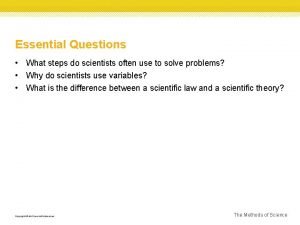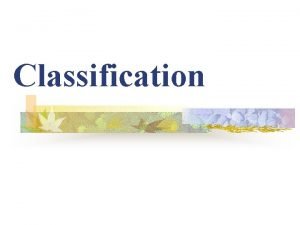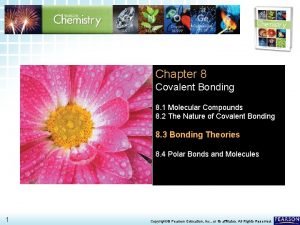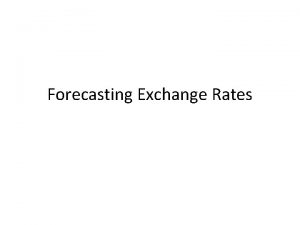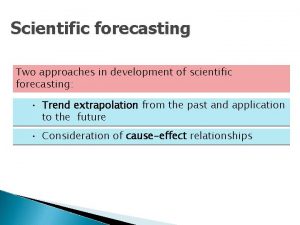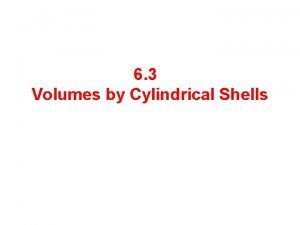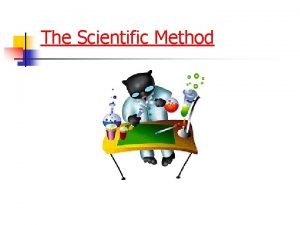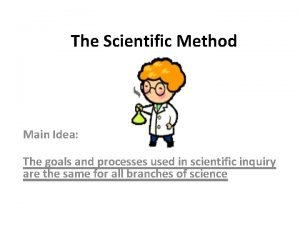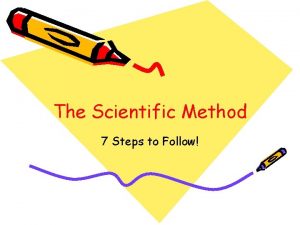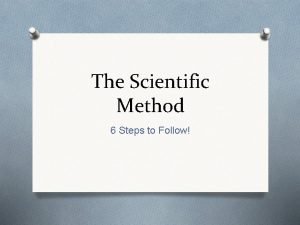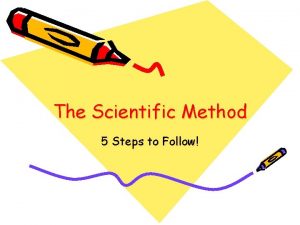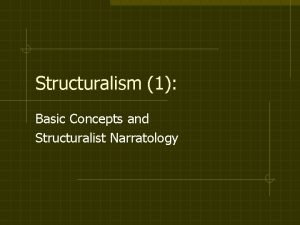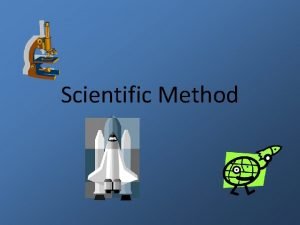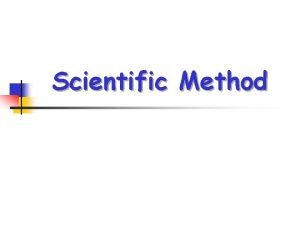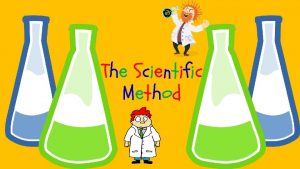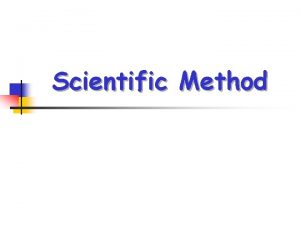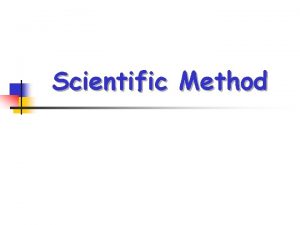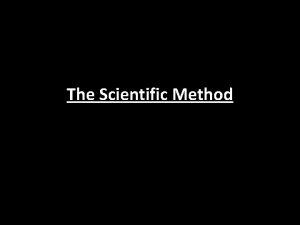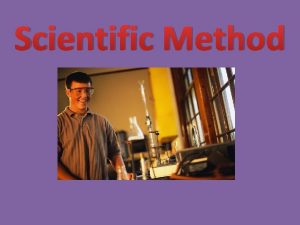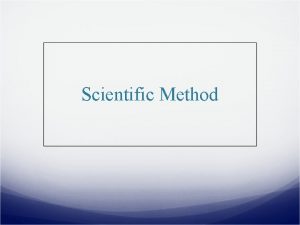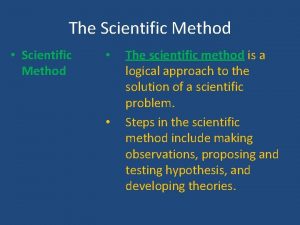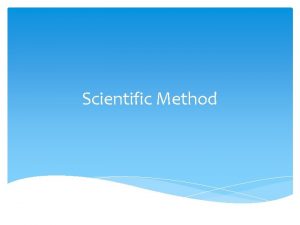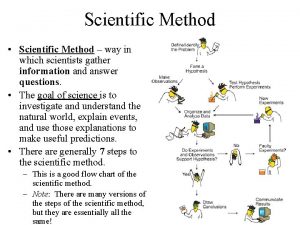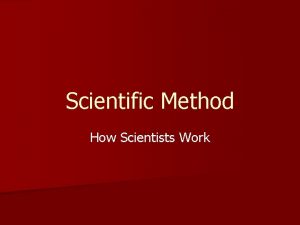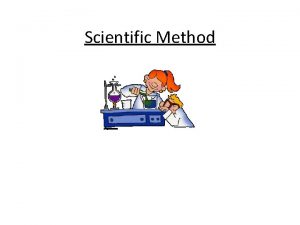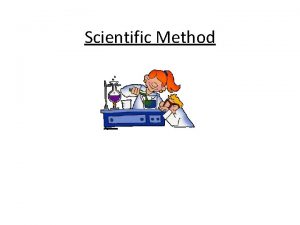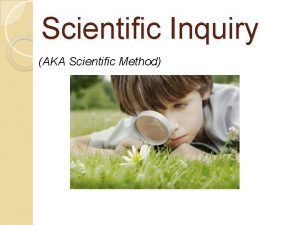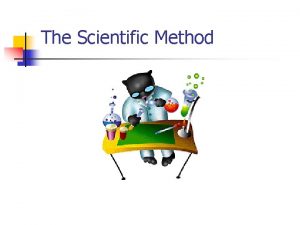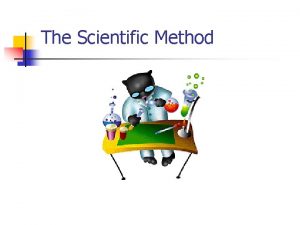Scientific Method Scientists use two main approaches to




























- Slides: 28

Scientific Method

• Scientists use two main approaches to learn about nature – Science • Is a way of knowing • Seeks natural causes for natural phenomena • Discovery Science • Hypothesis Based Science

• Scientists describe some aspect of the world and use inductive reasoning to draw general conclusions

• Scientists attempt to explain observations by testing hypotheses

• Observations, questions, hypotheses as tentative answers to questions • Deductions leading to predictions, and then tests of predictions to see if a hypothesis is falsifiable

• Questions or statements that are testable through experimentation or observation • If - then format • Preliminary explanation to problem

Scientific Method • Collaborate • Share info • Build upon other work

Scientific Method • 1. Observe • 2. Define problem or question • 3. Form a hypothesis • 4. Test hypothesis with a controlled experiment

Scientific Method • 5. Observe and record results • 6. Form conclusions by confirming or modifying the hypothesis • 7. Report Results

Observations Question Hypothesis # 1: Dead batteries Hypothesis # 2: Burnt-out bulb Prediction: Replacing batteries will fix problem Prediction: Replacing bulb will fix problem Test prediction Test falsifies hypothesis Test prediction Test does not falsify hypothesis

Theory • Explains current observations and predicts new observations • Supported repeatedly by data • Can be changed or discarded

• Tests the predictions made by a hypothesis • Double Blind • Controlled

• One group receives the drug to be tested; One group receives the placebo • Researchers do not know which subject is receiving the actual drug • Eliminates the bias that may influence the results

• Experiment isolates a single factor that is directly responsible for an effect.

• Condition in the experiment that differs

• Independent Variable: Variable that is independent of experiment – p. H, time, temperature • Dependent Variable: • What you are testing – Dependent of results of experiment

• Provides a standard of comparison for the one factor in the experiment that varies

A Case Study of Hypothesis-Based Science – In experiments designed to test hypotheses • The use of control groups and experimental groups helps to control variables 100 84% Figure 1. 8 B Figure 1. 8 C Percent of total attacks on artificial snakes 83% Artificial king snakes 80 Artificial brown snakes 60 40 20 0 17% Coral snakes absent Figure 1. 8 E 16% Coral snakes present

• Not all science discoveries strictly follow the “scientific method”. Which of the following would best be described as discovery science? – – Sequencing the human genome. Describing a new bird species from the Philippines. A project to find preserved specimens of the probably extinct Rocky Mountain locust frozen in glaciers. All of the above.

• Not all science discoveries strictly follow the “scientific method”. Which of the following would best be described as discovery science? – All of the above.

• These two snakes look remarkably similar to each other. The coral snake (right) is very poisonous to vertebrates. Hypotheses: • H 1: The coral snake’s bright color pattern serves to warn off potential predators. • H 2: The king snake suffers less predation because it mimics or looks like the coral snake. • H 3: The protection that king snakes receive by mimicking coral snake will depend on the presence of coral snakes.

• A team of scientists designed an investigation that used artificial snakes to test the previous hypotheses. • Which of the previous hypotheses are supported by the results displayed at the right? – H 1: The coral snake’s bright color pattern serves to warn off potential predators. – H 2: The the king snake suffers less predation because it mimics or looks like the coral snake. – H 3: The protection that king snakes receive by mimicking coral snake will depend on the presence of coral snakes. – Both 1 and 2

• A team of scientists designed an investigation that used artificial snakes to test the previous hypotheses. • Which of the previous hypotheses are supported by the results displayed at the right? – Both 1 and 2

• Biologists placed artificial snake mimics in two different localities to test the hypothesis that looking like a poisonous snake only works where the poisonous snake is found: 1. Outside of the coral snake range—only king snakes present. 2. Inside the coral snake range—both coral and king snakes are present.

• The data graphed at the right _____ the hypothesis that the effectiveness of mimic coloration depends upon the presence of the poisonous model is: – – – supports does not support is irrelevant to

• The data graphed at the right _____ the hypothesis that the effectiveness of mimic coloration depends upon the presence of the poisonous model is: – supports

• Based on this data which of the following is a logical hypothesis or prediction? – – – King snakes outside of the range of coral snakes will more closely resemble coral snakes than populations of king snake living within the range of coral. King snakes outside of the range of coral snakes will not resemble coral snakes as closely as populations of king snakes that live within the range coral snakes. Neither prediction is valid.

• Based on this data which of the following is a logical hypothesis or prediction? – King snakes outside of the range of coral snakes will not resemble coral snakes as closely as populations of king snakes that live within the range coral snakes.
 Information gathered during an experiment
Information gathered during an experiment Sig fig examples
Sig fig examples What steps do scientists often use to solve problems?
What steps do scientists often use to solve problems? Why do scientists classify organisms?
Why do scientists classify organisms? Bond 8 generacji
Bond 8 generacji Corporate governance is which approach
Corporate governance is which approach The main approaches to forecasting exchange rates are
The main approaches to forecasting exchange rates are How is a scientific law different from a scientific theory?
How is a scientific law different from a scientific theory? The two general approaches to forecasting are
The two general approaches to forecasting are The two dominant agile approaches are
The two dominant agile approaches are Shell method examples
Shell method examples Symposium introduction
Symposium introduction Future i will
Future i will Stated main idea and implied main idea
Stated main idea and implied main idea Void main int main
Void main int main Tera prefix value
Tera prefix value 7 steps of the scientific method
7 steps of the scientific method 7 steps of the scientific method
7 steps of the scientific method Goals of scientific method
Goals of scientific method Brainpop pop art quiz answers
Brainpop pop art quiz answers 7 step of scientific method
7 step of scientific method 6 steps in the scientific method
6 steps in the scientific method What are the 5 steps in the scientific method
What are the 5 steps in the scientific method How does the scientific method work
How does the scientific method work Structuralism in linguistics
Structuralism in linguistics What are scientific skills
What are scientific skills Steps of scientific method
Steps of scientific method Scientific method example
Scientific method example Scientific method steps
Scientific method steps


